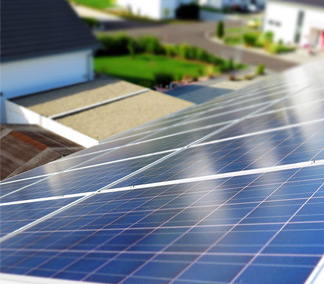What is an Energy Retrofit ?

In new buildings, adaptation to the requirements of the Energy Transition means to drastically reduce the building’s energy needs, by constructing passive or low energy.
When renovating, by cons, and especially for the energy retrofitting of buildings currently inhabited or in use, reducing the building’s energy needs cannot be pushed as far as in new construction. Therefore, to make a carbon neutral energy renovation, it is important to balance the reduction of energy consumption with the local renewable energy production, harvested around the building, or directly on the building envelope.
When a building is located on a large field, various forms of renewables can be used, such as solar, geothermal or wind energy.
In urban environments, when the building uses the entire area, or substantially most of its own grounds, it is unfortunately very difficult to use geothermal and wind energy, and one can only take advantage of the two forms of solar energy: photovoltaic and thermal.
How to perform the Energy Retrofit of an urban building ?
The Energy Retrofit of an urban building (house, building, commercial) involves:
- Modifying the two envelopes that affect the building’s efficiency: the envelope of the protected volume must be carefully isolated andventilated to minimize the heating needs of the building ; and the outer shell available to light should be optimally exploited to reap a maximum of solar energy, both photovoltaic and thermal, so that the building can produce most of the energy it consumes for the heating needs of its inhabitants, their needs for hot water, cooking, power supply (lighting, appliances, TV-stereo-video, computers and other…), and even the recharge needs of their electric vehicles, if necessary;
- Replacing heaters using fossil (gas, oil) or polluting fuels (fireplace, wood stove, pellet stove or cassette) with a heat pump, which consumes 3-4 times less energy than a boiler or stove;
- Replacing incandescent lights with LEDs, they consume 4-5 times less energy;
- Replacing the gas stove with electric cooking equipment: induction or glass ceramic cooktop, electric or microwave oven;
- Replacing old appliances such as fridge and freezer with recent devices labeled AA +;
- Installing batteries to store electricity produced at certain times of the day so you can use it at other times;
- For buildings equipped with old energy-hungry elevators, replacing them with elevators with energy recovery by regenerative braking;
- Organizing the recovery of rainwater and its reuse in the building.
What is the Complete Energy Retrofit of a household ?
In addition to the Energy Retrofit of their homes, the Complete Energy Retrofit of a household also requires the replacement of fossil fuel powered vehicle(s) with electric vehicle(s), and the installation of a charger for this(these) vehicle(s).
